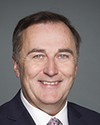Thank you.
I have worked with veterans intensely for over two years now with the change of the policy from the 10 grams approved down to three grams being approved for veterans. I'm going to speak to you today from a perspective of the veterans' well-being and my mandate as a doctor following the Hippocratic oath to do no harm.
The first part of the presentation will be some of the neuroscience behind PTSD and what the veterans are dealing with so that you have a better understanding of what we're dealing with. I don't think anybody has spoken about this directly. Second, we will launch into the trenches, into the battleground.
With PTSD, what is happening is that the on system of the brain is in flight. Their brains are going 900 kilometres an hour. There are no brakes, which causes a problem at night as well. You have a daytime hyper-arousal, and then you have the nighttime hyper-arousal. With that hyper-arousal at night, you have fragmentation of sleep; you have nightmares and you have acting out. Because of the lack of good quality sleep, you then have more cognitive issues during the day, problems with memory and concentration and problems with impulse control.
As background, this is a study done by Dr. Moldofsky at the London OSI clinic. They followed veterans for 14 years. Irrespective of combat or not, veterans whose brains did not turn off, whose brains were set to fight and flight.... It could be from childhood or from other traumatic events even prior to entering the military. If they had a brain that was set to 900 or 800 kilometres an hour, they were more predisposed to develop PTSD than other servicemen, regardless of whether they saw combat or not.
We are dealing mainly with a problem, in terms of PTSD, with the brain not turning off. What I have found in our studies is objective data of before and after cannabis use of helping the brain to slow down, to boost the off system of the brain, which is the relax and restore system.
This is an example of a graph of the interference pattern that happens in the brain at night when the brain is trying to turn off. Those highlighted parts in grey are breakthrough sympathetic nervous system bursts, which means the fight and flight system is popping up. The brain is trying to turn on, but their PTSD brain is like a light switch that keeps flopping back on, on and on again.
With civilians, their brains might be set to 300 kilometres during the day, and at night they're going down to zero. If we're lucky, a veteran might go from 900 down to 600, but they're not getting down to zero and turning off properly.
With medical cannabis, we have been able, in our clinic, using low CBD microdose through the day and CBD with higher THC at night, to improve these objective measures in sleep. The reason I treat and microdose during the day is so that their nervous system doesn't ramp up to 900. With the CBD oil microdosed through the day, I can have their nervous system stay at 400 or 500 kilometres an hour and not be triggered into massive fight and flight. At night, we're going to sleep from 500 to zero rather than 900 to zero.
Many of my veterans, as Dr. Walsh said, will tell me, “The first time I smoked a spliff, I got the first good night's sleep in 15 years.” They've gone from fragmented sleep, waking up once every hour or two, to four to five hours straight, solid sleep.
You might not be aware that poor sleep quality makes pain worse in the body because, if you have extended periods of low quality sleep—you try it, deprive yourself three nights of sleep—the inflammatory factors in your body will get regulated up, and then you get aches and pains all over your body.
They might have an initial operational stress injury like a shoulder or knee injury, but then you layer on top the masked inflammatory effect throughout the body. You have a double-pain syndrome. You have someone who doesn't sleep. They have the initial pain from injury and then they have widespread musculoskeletal pain throughout their body.
My focus in dealing with PTSD and chronic pain, because the pain also exacerbates the fight and flight system, is to look at the parasympathetic nervous system. I see medical cannabis as the first step in decreasing parasympathetic nervous system tone. From our sleep studies we've been able to show that we are actually decreasing this increased sympathetic fight and flight drive to enhance the parasympathetic nervous system tone, the off system of the brain.
Once the veteran has decreased their brain process from 900 kilometres an hour, to 300 or 400 or maybe 500 kilometres an hour, then they can make it to the psychologist, to rehab programs, to other things that will be helpful, and they will remember them. When they are in a PTSD brain, they do not encode memories. Once they are able to do that, then their healing process moves further along. I see medical cannabis as a step in the multimodal approach towards healing.
We have an opportunity in Canada to be world leaders in this. We really need to have the same fighting noble integrity that our service people have in dealing with this. There are cutting-edge neuroscience techniques like neurofeedback that can be used very effectively once their brain has been stabilized on the medical cannabis first.
On pulse electromagnetic field therapy, I'm one of the first doctors in North America to have a pulse electromagnetic field machine that is used in rehab hospitals in Italy with great effect. The American military is extremely interested in this technology for their veterans. As well, there are other techniques like yoga, tai chi, swimming, all of which enhance the off system of the brain.
As was referred to earlier cannabis decreases inflammation. When you have inflammatory factors circulating throughout the body and within the blood, they go to the brain. The brain says, “Oh, my, there's inflammation. There's some danger. I cannot turn off. I must remain in a fight and flight state.” Not only is the cannabis helping regulate the on-off system of the brain, it's also decreasing the inflammatory factors that were previously sending the signals to the brain that it must stay on high alert.
A very important book that you must read to understand PTSD is The Polyvagal Theory by Porges. Basically, what we're talking about in the PTSD brain is that you are staying in the reptile part of the brain. You do not have access to the emotional part of your brain, which is the centre brain, nor do you have access to the social part of your brain, which is social conditioning. When you talk about unbridled anger after being in military combat, you're talking about being stuck in the fight or flight reptile brain. What cannabis does—and I've had personnel tell me this—is it slows down your reaction time long enough so you can start to reset the connections between the reptile brain, the emotions and socialization.
I'll never forget the story that one veteran told me. He said that when he was going down an escalator he thought for sure there was someone standing with an AK-47 at the bottom. He was ready to go. His cannabis allowed him to slow down his reaction time long enough to realize it was a mother holding a baby.
These are the brains we're dealing with—900 kilometres an hour. They are trained that way because if they don't react fast enough, someone is dead, or they're dead.
The other piece of military training that I want to share with you, which no one's talking about from a scientific perspective, is that they are trained to disconnect from their hearts so that they can kill. What they are then set to is the military compass. They belong to the military. The military says, “Jump” and they say, “How high?”
When you are released from the military you are ripped away from that compass, and then you are lost. You're not even connected with your own heart. Part of connecting with your heart is being a socialized member of society.
First, we must calm down their brain and bring them to a point where they are not in the fight or flight mode of PTSD, so they can start to reset the connections between the emotional and socialized brain to rehabilitate and return to civilian society. There needs to be just as much retraining once they come back as there was upfront to train them to go.
This is an issue, in terms of policy within the government and within medicine. They are looking at it ass-backwards. Instead of having the veterans going directly to rehab when they come back, the veteran has to prove that something is wrong with them. It should be assumed that something is wrong from combat immediately and then looked at and addressed. Don't play catch-up afterwards. We're wasting too much taxpayers' money playing catch-up years and years later. Veterans have lost five to 10 years of their lives.
Yes, there is a place for the pharmaceuticals, but I see them as a cast that you put on when you have a broken leg. What happens if you leave a cast on a broken leg? You lose the function of the joint. That's what has happened to my veterans. They've lost five to 10 years of their lives drooling on the couch, losing wives and losing children because they've been zombified. There is a place for those medications acutely, but the next transition phase could be a brace that moves, like cannabis. Then once we have them doing the rehab, through the underlying psychological and physical work and the cutting-edge neuroscience techniques that are available globally, we can have them functioning and rehabilitated.
I have never met a veteran who didn't want to get up and work and do something. Their drive is to serve and protect and help mankind. They don't want to be sitting there drooling on the couch, but at every turn, they're foiled over and over again by a system that is backlogged with paperwork.


